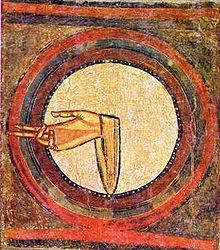

The Hand of God, or Manus Dei in Latin, also known as Dextera domini/dei (the "right hand of God"), is a motif in Jewish and Christian art, especially of the Late Antique and Early Medieval periods, when depiction of Yahweh or God the Father as a full human figure was considered unacceptable. The hand, sometimes including a portion of an arm, or ending about the wrist, is used to indicate the intervention in or approval of affairs on Earth by God, and sometimes as a subject in itself. It is an artistic metaphor that is generally not intended to indicate that a hand was physically present or seen at any subject depicted. The Hand is seen appearing from above in a fairly restricted number of narrative contexts, often in a blessing gesture (in Christian examples), but sometimes performing an action. In later Christian works it tends to be replaced by a fully realized figure of God the Father, whose depiction had become acceptable in Western Christianity, although not in Eastern Orthodox or Jewish art.[1] Though the hand of God has traditionally been understood as a symbol for God's intervention or approval of human affairs, it is also possible that the hand of God reflects the anthropomorphic conceptions of the deity that may have persisted in late antiquity.[2]
The largest group of Jewish imagery from the ancient world, the 3rd century synagogue at Dura-Europos, has the hand of God in five different scenes, including the Sacrifice of Isaac,[3] and no doubt this was one of the many iconographic features taken over by Christian art from what seems to have been a vigorous tradition of Jewish narrative art. Here and elsewhere it often represents the bath Kol (literally "daughter of a voice") or voice of God,[a] a use also taken over into Christian art.
The hand may also relate to older traditions in various other religions in the Ancient Near East.[4] In the art of the Amarna period in Egypt under Akhenaten, the rays of the Aten sun-disk end in small hands to suggest the bounty of the supreme deity. Like the hamsa amulet, the hand is sometimes shown alone on buildings, although it does not seem to have existed as a portable amulet-type object in Christian use. It is found from the 4th century on in the Catacombs of Rome, including paintings of Moses receiving the Law and the Sacrifice of Isaac.[5]
There are numerous references to the hand, or arm, of God in the Hebrew Bible, most clearly metaphorical in the way that remains current in modern English, but some capable of a literal interpretation.[1] They are usually distinguished from references to a placement at the right hand of God. Later rabbinic literature also contains a number of references. There are three occasions in the gospels when the voice of God is heard, and the hand often represents this in visual art.[6] Gertrud Schiller distinguishes three functions of the hand in Christian art: as symbol of either God's presence or the voice of God, or signifying God's acceptance of a sacrifice.[7]
- ^ a b "Anthropomorphism", Jewish Virtual Library, especially the section on Jewish art near the end.
- ^ Bar Ilan, 321–35; Roth, 191; C. W. Griffith and David Paulsen, 97–118; Jensen, 120–21; Paulsen, 105–16; Jill Joshowitz, The Hand of God:The Anthropomorphic God of Late Antique Judaism: Archaeological and Textual Perspectives, (B.A. thesis, Yeshiva University, 2013).
- ^ Hachlili, pp. 144–145
- ^ Summarized by Hachlili, 145
- ^ Hachlili, 146
- ^ "in Ravenna and in Western art from the ninth until the eleventh centuries" according to Schiller I, 149, although Western examples of the hand in depictions of these occasions extend well before and after these dates.
- ^ Schiller, II 674 (Index headings)
Cite error: There are <ref group=lower-alpha> tags or {{efn}} templates on this page, but the references will not show without a {{reflist|group=lower-alpha}} template or {{notelist}} template (see the help page).